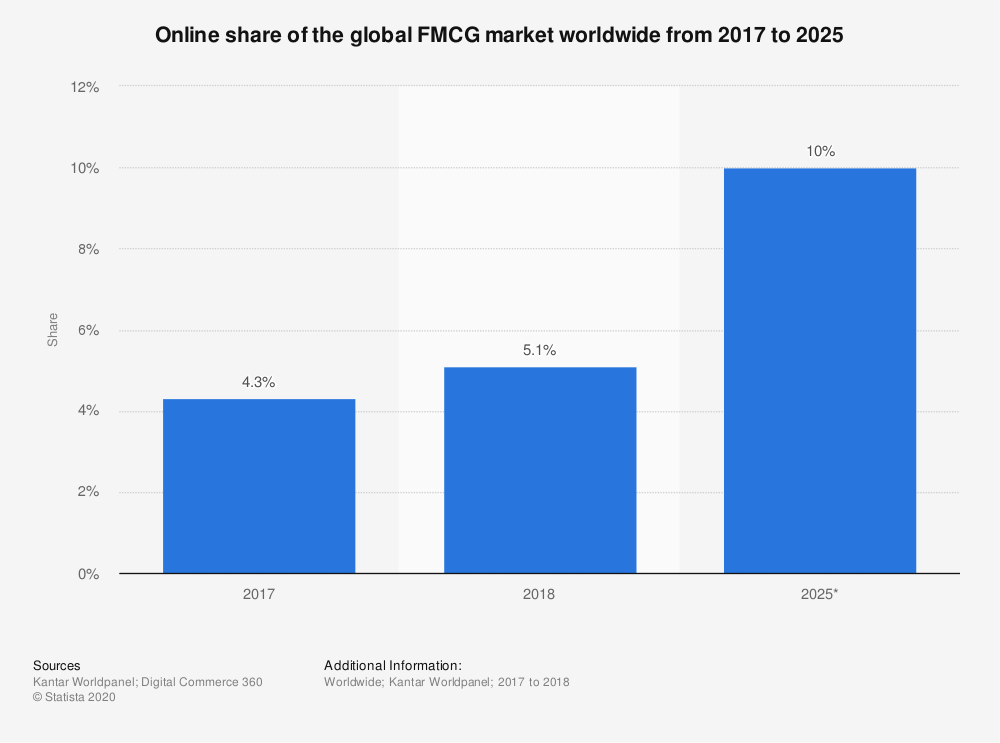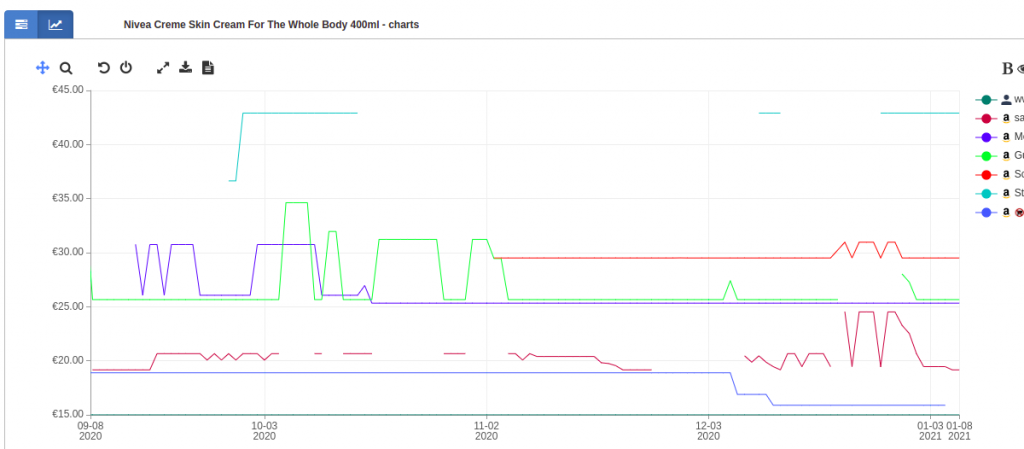Price monitoring in the FMCG (CPG) industry
- 02 February 2021

In this article, you will find tips on how to use price tracking software in the FMCG (Grocery) industry. You will find insights for online shops which want to stay competitive on this market.
We will cover the following topics:
- What are the characteristics of the FMCG (grocery) market?
- What are the challenges related to price monitoring and dynamic pricing (repricing)?
- Which functionalities and reports provided in the price tracking tool are crucial?
- How to start monitoring prices systematically?
1. What are the characteristics of the FMCG market?
FMCG (fast moving consumer goods) market / CPG (consumer packaged goods) market covers products which customers buy regularly at relatively low prices and consume rapidly. The most popular products in this category are:
- Packaged foods
- Beverages
What is characteristic of this market?
- The online sales have been gaining importance – there has been a 19% increase in the share of online sales in the total sales between 2017 and 2018 :

- COVID pandemic had an impact on the customers’ behaviour. According to PwC’s “Global Consumer Insights Service”, 63% of customers are buying more groceries online / by phone than before the social distancing:
 Source: PwC, “Global Consumer Insights Service”, 2020
Source: PwC, “Global Consumer Insights Service”, 2020
- Healthy products are gaining importance – the consumer awareness is rising which accelerated during the pandemics as well. According to the above mentioned study, 63% of customers are focused more on taking care of their diet as a result of COVID-19. McKinsey draws similar conclusions about UK customers – they claim that 50% of them are conscious eaters.
- The pace of increase in average economic profit has decreased significantly in the last years – according to the McKinsey study, it amounted to 3.2% CAGR in 2010-2018 vs. 10.8% in 1994-2009. It means that companies operating in the CPG industry need to think through their pricing strategy to be profitable.
- Small and medium sized CPG brands have been gaining importance in comparison to the leading brands.
- Customers expect to make more purchases online after COVID-19 as well:

Source: McKinsey
The challenge which many companies face when tracking prices of FMCG products are several variations of products (e.g. 500 ml and 1 l bottles). With the proper software for price monitoring, it shouldn’t be a problem though – then every different package of product is treated separately.
As we showed before, online sales have big importance in the FMCG sector which is a trend which many companies operating in this segment have to adapt to. And what is the most important factor for customers when they buy online? As several researches show, price is the most relevant factor for customers when purchasing online.
It means that an online shop which wants to be popular amongst customers should offer competitive prices. Without a price monitoring tool it is almost impossible to track all the offered SKUs in all the relevant channels every day. With price tracking software, you can have a short glimpse on the panel every day. You can choose competitors which you want to compare to and check your shop’s ranking (position) in comparison to them:

Other relevant information displayed is about opportunities for profit increase or important changes in the market. In order to always be up to date, you can receive such insights in e-mail alerts as well.
The second functionality which is often used is dynamic pricing (repricing). It gives you a possibility to change the price in the online shop according to the current market position. How does it work? You set customized rules according to which the prices in your shop should be changed. It can include such rules as “being the cheapest on Google Shopping”, “being cheaper than the average on the market” provided specific conditions (e.g. minimum profit margin). Thanks to that, you can automate your pricing without additional manual work and time needed. If you have seen competitors being always 5 cents below your price – it is very probable that they use such rules for their pricing.

3. Which functionalities and reports provided in the price tracking tool are crucial?
What is relevant when looking for a price monitoring & repricing software?
- Clear market overview – price monitoring tool should enable you not only to check your position on the market but also to identify the most relevant competitors. In the Dealavo tool, you can see your position on the market in regard to every single product and see how many other online shops offer it. You can also easily see which products you have in common with each of the competitors.
- All data integrated in one place – thanks to having the data from all the platforms in one panel, you can understand the situation with one glimpse only.
- Data displayed in charts – there is no easier way to see a trend than looking at a chart. That’s why at Dealavo we try to visualize the data in very intuitive way – with charts including information about different competitors’ prices in a specified time range

- Dynamic Pricing – to react quickly, it is recommended to implement dynamic pricing based on customizable conditions. Some shops use different rules depending on the channel or country – with Dealavo software it is not a problem.
- E-mail alerts – to be always up to date with relevant changes in the market, you should make sure you can receive e-mail notifications every time there is an important price increase / decrease in the market, or when there is an opportunity to increase your price etc. With Dealavo, you can choose when exactly you want to receive such an e-mail (e.g. when the prices decrease more than 15%).
- Different variants tracking – it is important to take into account different packages of the products. In the FMCG price tracking it is a common challenge, but with such tools as Dealavo, you get each variant treated as a separate SKU.
- API integration – to implement data from the tool to your system, API integration is crucial – especially if you monitor hundreds or thousands of products. With Dealavo, you always get an API.
- Data available in csv – for data analysis, it can be important to have data in csv format as well. Dealavo offers it for all of the clients.
- Availability information – it happens that your competitors offer products at very low prices, but then it turns out that they are not available. It can even happen that even though there are several listed offers, you are the only shop which actually has the product. In the CPG segment availability is especially important – customers usually want to receive the product as soon as possible and don’t wait until the product is available with the purchase. That’s why it is crucial to have availability information in the tool.
- Frequency of the updates – to react fast, you need frequent updates. At Dealavo, we can offer you to refresh informationi even every 15 minutes.
4. How to start monitoring prices systematically?
Once you decide price monitoring and repricing are crucial, here are the next steps you should follow:
- Fill the contact form to have a call during which we could understand your needs and discuss how we can help.
- See the demo of Dealavo price monitoring tool
- Choose the products you would like to monitor
- Choose the websites you would like to track prices on – these can be marketplaces, price comparison websites or online shops
- Our team will do the rest!
Learn more about price tracking in the other industries: